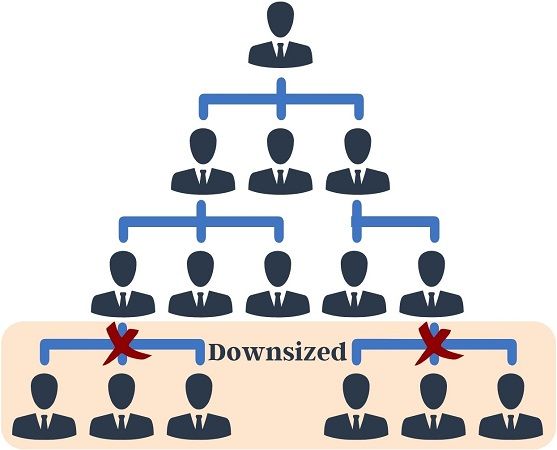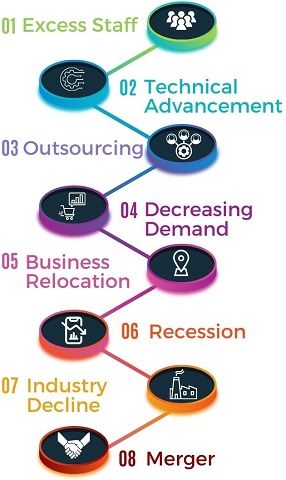Layoffs and Downsizing have been the talk of the town in recent years. Many big organizations are announcing massive layoffs worldwide. It impacts many people at once and leaves some adverse consequences.
Here, we will understand the reasons behind adopting downsizing as a tactical move.
In brief, it is minimizing the workforce’s size to make the organization leaner. For this reason, a majority also refer to it as ‘Trimming the Fat‘ of an organization.

It is a process wherein organizational tasks and activities are directed towards the optimization of:
- Performance
- Productivity
- Efficiency
- Competitiveness
Organizations plan to downsize when they are unable to maintain their current expenses. Also, they use it to remain solvent and competent.
Thus, it is the organization’s strategic choice by which it can optimize performance and reduce cost. For example, ABS company has eliminated about 20% of the employees from the operational level.
It is alternatively known as ‘Corporate Downsizing‘ and ‘Corporate Reorganization‘.
Organizations may implement it by eliminating job posts and restructuring.
Sometimes, the downsized employee is entitled to a few months salary in advance. On the contrary, some organizations may pay employees a fixed amount as compensation.
It is one of the most challenging decisions for any organization. As, it affects a large volume of employees and has severe consequences.
It is often used interchangeably with Layoffs, but they are a bit different from one another. Downsizing involves the permanent termination of employees. In contrast, layoffs can be both temporary and permanent.
Besides, Downsizing is one of the popular strategies for Employee Separation. Unlike Rightsizing, it compulsorily involves the layoff of employees.
Content: Downsizing
Example
Post deadly pandemic many companies announced massive layoffs. They suffered huge losses during the lockdown and started facing difficulty in meeting their operating expenses.
Recently, approx.110 companies announced layoffs worldwide, including Microsoft and Twitter.
Microsoft Corporation is cutting about 5% of its workforce in 2022 and 2023. The reasons for the layoff are the company’s economic downturn and structural changes.
Twitter reduced its headcount from 7500 to 2700 a few months back. They announced layoffs to hire more engineering and sales personnel in their team.
Reasons – Why do Companies Downsize?
Usually, companies downsize when they can only survive by limiting their operations. And the fastest way to reduce it is through layoffs. Consequently, they immediately get control over their costs.
Besides, they reorganize their internal structure to become more competent. So that they can bring their declining profitability back on track.
The reasons for choosing to downsize as a business strategy are as follows:

- Excess Staff: The organization may accumulate extra staff due to wrong human resource planning practices.
- Technical Advancement: The introduction of new technologies leads to a change in the men-machine ratio.
- Outsourcing: This strategy is helpful when the organization is planning to outsource its operations.
- Decreasing Demand: It is helpful when the demand for goods and services declines in the market.
- Business Relocation: It helps in reducing excess workforce while relocating the business.
- Recession: During the recession, companies prefer to cut jobs and save costs.
- Industry Decline: In the declining phase of an industry, companies often downsize to survive.
- Merger: During mergers, many job roles get duplicated. Therefore, companies downsize the excess staff.
Advantages
The corporate restructuring benefits organization in the following ways:
- Reduces Cost: It is the fastest way to minimize cost. This is because, a significant amount of personnel moves out of the organization.
- Streamlining Hierarchy: Restructuring helps in redefining the operations and streamlining the hierarchy.
- Avoid Duplications: Through this process, companies identify and exclude similar posts.
- Eliminate Competition: It helps cut competition by optimizing performance.
- Sail through Economic Crisis: It plays a crucial role in sailing through the economic crisis and remaining solvent.
Consequences of Downsizing
Along with many advantages to the organization, downsizing impacts employees adversely. Here are some of the consequences following its implementation:
- It leaves the downsized employee unemployed.
- The remaining employees suffer job insecurity.
- It may greatly impact the organization’s skill base.
- It leaves a negative imprint on the customer’s mind.
- The existing employees may get overburdened by the work.
Alternatives of Downsizing
Companies can consider the alternatives listed below before permanently laying off employees:
- Temporary Layoff
- Freeze Salaries
- Cut Rewards and Bonuses
- Eliminate some Perquisites
- Stop Hiring
- Offer VRS
- Transfers
- Postpone Business trips
Types of Downsizing
Retrenchment/Fortification – Reducing the Workforce
It involves cutting down costs by terminating employees. The termination may be due to the employee’s incapability or excess headcount.
Example: Laying off thousands of employees to survive an economic downturn.
Downscaling – Restructuring the Workforce and Workplace
It is the corporate restructuring strategy that reduces tangible assets along with the workforce. Here, the changes are irreversible. Also, it helps eliminate cut-throat competition.
Example: Selling off the manufacturing plant yields losses and layoff its workers.
Down Scoping – Redesigning the Core Work
It includes the analysis and elimination of the non-core activities of the organization. It helps streamline core activities and reduces diversification.
Example: Closing the entire product line of the non-performing products.
Ethical Issues
The organization must keep the following ethical issues in mind during the entire downsizing process:
- Respect and treat the laid-off employees well.
- Provide an apparent reason behind their layoff.
- Try alternative strategies before downsizing.
- Management must ensure the fair division of work.
- Must formulate clear policies and plan for justifiable dismissals.
- Management must resolve the doubts of the employees during the process.
- Conduct counselling sessions and guidance programmes for the parting employee.
Final Words
All in all, it includes employee termination at a large scale with the motive of saving money. It keeps the organizations profitable even in economic slowdowns.
However, a business must always keep corporate reorganization as a last resort. Over the years, it is becoming a matter of concern worldwide. Hence, it needs to be addressed to ensure equitable employment practices.

Leave a Reply